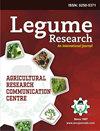不同间作制度对床栽鹰嘴豆生产潜力和经济效益的影响
IF 0.8
4区 生物学
Q3 AGRONOMY
引用次数: 0
摘要
背景:鹰嘴豆(Cicer arietinum L.)是世界上仅次于干豆和豌豆的第三大豆类作物。在豆类中,鹰嘴豆是印度的主要作物,但对于国际市场来说,鹰嘴豆的质量必须提高,这可能通过评估不同的种植技术来实现。旁遮普省还没有关于鹰嘴豆不同作物间作的系统研究和适当的技术报道。本研究旨在了解不同间作方式对床播鹰嘴豆生长和产量的影响。方法:在2017年和2018年rabi季节进行田间试验,评价床栽鹰嘴豆间作系统的生产力和经济可行性。试验采用随机区组设计,包括4个重复,13个处理。结果:单鹰嘴豆的种子产量最高,与鹰嘴豆+燕麦饲料(2:1)、鹰嘴豆+燕麦饲料(4:1)和鹰嘴豆+亚麻籽(4:1)套作的种子产量在统计学上相当。油菜和大麦间作对鹰嘴豆的产量和产量性状有不利影响。2017年和2018年,行比为2:1的鹰嘴豆+燕麦饲料的鹰嘴豆当量产量最高,分别为24.07和24.77 q/ha,系统生产力最高,分别为15.96和15.60 kg/ha/day。鹰嘴豆与燕麦饲料(2:1)套作的净收益(63098卢比和70924卢比/公顷)、效益成本比(1.47卢比和1.63卢比)和生产效率(417.9卢比和446.1卢比/公顷/日)均高于单鹰嘴豆(44862卢比和53769卢比/公顷、1.21卢比和1.41卢比)。鹰嘴豆+燕麦饲料(4:1)、鹰嘴豆+亚麻籽(2:1)和鹰嘴豆+亚麻籽(4:1)的鹰嘴豆当量产量、净回报率和效益成本比均显著高于单鹰嘴豆。本文章由计算机程序翻译,如有差异,请以英文原文为准。
Production Potential and Economic Returns of Bed Planted Chickpea (Cicer arietinum L.) as Influenced by Different Intercropping Systems
Background: Chickpea (Cicer arietinum L.) is the third most important pulse crop produced after dry bean and peas in the world. Amongst pulses, chickpea is the major crop in India but for international market the quality of this crop has to be improved which may be possible by evaluation of different planting techniques. No systematic research and adequate technologies have been reported in Punjab on intercropping of different crops in chickpea. The current study aimed to find out the effect of different intercrops on growth and yield of bed planted chickpea based intercropping systems.Methods: A field experiment was carried out during the rabi season of 2017 and 2018 to evaluate the productivity and economic viability of bed planted chickpea based intercropping systems.The experiment was laid out in a randomized block design consisting of four replications with thirteen treatments.Result: Results showed that sole chickpea recorded highest seed yield and it was statistically at par with seed yield that obtained under chickpea + oats fodder (2:1), chickpea + oats fodder (4:1) and chickpea + linseed (4:1) intercropping systems. However, oilseed rape and barley as intercrops showed adverse effect on yield and yield attributes of chickpea. Chickpea + oats fodder in 2:1 row ratio recorded highest chickpea equivalent yield of 24.07 and 24.77 q/ha and system productivity of 15.96 and 15.60 kg/ha/day during 2017 and 2018, respectively. Higher net returns (Rs. 63098 and 70924/ha), benefit cost ratio (1.47 and 1.63) and production efficiency (417.9 and 446.1 Rs/ha/day) were also recorded in chickpea + oats fodder (2:1) intercropping system over sole chickpea (Rs. 44862 and 53769/ha and 1.21 and 1.41) during both the years. Chickpea + oats fodder (4:1), chickpea + linseed (2:1) and chickpea + linseed (4:1) also recorded significantly higher chickpea equivalent yield, net returns and benefit cost ratio as compared to sole chickpea.
求助全文
通过发布文献求助,成功后即可免费获取论文全文。
去求助
来源期刊

Legume Research
AGRONOMY-
CiteScore
1.30
自引率
37.50%
发文量
256
审稿时长
6-12 weeks
期刊介绍:
Legume Research An International Journal. The Journal is an official publication of Agricultural Research Communication Centre. It is designed to bring out the original research articles on genetics, breeding, physiology, bacterial avtivity, production, quality, biochemistry and seeds of legumes crops. The objective of the journal is to serve as a forum for scientific community to publish their research findings on legumes ans to provide basis for new research. Journal is being scanned in the important indexing and abstracting services.
 求助内容:
求助内容: 应助结果提醒方式:
应助结果提醒方式:


